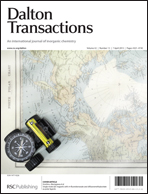o-Imino-p-R′-benzosemiquinone anion radical (LR′IS˙−) complexes of oxidovanadium(IV) of type [(L1R−)(VO2+)(LR′IS˙−)] (R = H, R′ = H, 1; R = H, R′ = –CMe3, 2; R = –CMe3, R′ = H, 3 and R = –CMe3, R′ = –CMe3, 4) incorporating the redox-innocent tridentate NNO-donor L1R− ligands (L1RH = 2,4-di-R-6-{(2-(pyridin-2-yl)hydrazono)methyl}phenol) were isolated and substantiated by elemental analyses, IR, mass, NMR and UV-vis spectra including the single crystal X-ray structure determinations. The V–Ophenolato (cis to the V![[double bond, length as m-dash]](https://www.rsc.org/images/entities/char_e001.gif) O) lengths spanning 1.905(3)–1.9355(15) Å in 1–4 are consistent with the coordination to the [VO]2+ state. The V–OIS (trans to the V
O) lengths spanning 1.905(3)–1.9355(15) Å in 1–4 are consistent with the coordination to the [VO]2+ state. The V–OIS (trans to the V![[double bond, length as m-dash]](https://www.rsc.org/images/entities/char_e001.gif) O) lengths, 2.1505(17)–2.1869(15) Å, in 1–4 are longer due to the trans influence of the V
O) lengths, 2.1505(17)–2.1869(15) Å, in 1–4 are longer due to the trans influence of the V![[double bond, length as m-dash]](https://www.rsc.org/images/entities/char_e001.gif) O bond. The V–NIS lengths, 1.906(3)–1.924(2) Å, in 1–4 are comparatively shorter due to the higher affinity of the paramagnetic [VO]2+ ion towards the LR′IS˙− anion radicals. Density functional theory (DFT) calculations using B3LYP, B3PW91 and PBE1PBE functionals on 1 and 2 authenticated that the closed shell singlet (CSS) solutions (dianionic o-amido-p-R′-phenolates (LR′AP2−) coordinated to VO3+, Type I) of 1–4 are unstable with respect to the open shell singlet (OSS) perturbations. Broken symmetry, BS (1,1) Ms = 0 (LR′IS˙− coordinated to the VO2+ ion, Type III) solutions of 1–4 are stable and reproduce the experimental bond parameters. Frozen glasses EPR spectra of [1–4]+ ions (e.g. g|| = 1.948, g⊥ = 1.978, A|| = 184 (22 G), A⊥ = 62(15 G) for [2]+) and unrestricted DFT calculations on [1]+, [2]+, [1]− and [2]− ions using doublet spin state elucidated that the reversible anodic waves at [0.15–0.31] V of 1–4 complexes are due to the oxidation of LR′IS˙− generating [(L1R−)(VO2+)(LR′IQ)]+ complexes (LR′IQ = o-imino-p-R′-benzoquinone) coordinated to the [VO]2+ ion (Type V) while the irreversible cathodic waves at −[1.08–1.49] V are due to the formation of unstable [(L1R−)(VO2+)(LR′AP2−)]− complexes (Type II). The second anodic waves at [0.76–0.89] V are assigned to a [VO]3+–[VO]2+ couple affording diamagnetic [(L1R−)(VO3+)(LR′IQ)]2+, [1–4]2+ complexes (Type VI) which are identified by UV-vis spectra, DFT and time dependent (TD) DFT calculations. Spectro-electrochemical measurements and TD DFT calculations on 1 and 2 disclosed that lower energy electronic absorption bands of 1–4 are due to the LMCT and CSS-OSS perturbation which disappear in [1–4]+ ions. [1–4]+ absorb at 600–650 nm due to d–d transitions and MLCT which are absent in VO3+ complexes, [1–4]2+.
O bond. The V–NIS lengths, 1.906(3)–1.924(2) Å, in 1–4 are comparatively shorter due to the higher affinity of the paramagnetic [VO]2+ ion towards the LR′IS˙− anion radicals. Density functional theory (DFT) calculations using B3LYP, B3PW91 and PBE1PBE functionals on 1 and 2 authenticated that the closed shell singlet (CSS) solutions (dianionic o-amido-p-R′-phenolates (LR′AP2−) coordinated to VO3+, Type I) of 1–4 are unstable with respect to the open shell singlet (OSS) perturbations. Broken symmetry, BS (1,1) Ms = 0 (LR′IS˙− coordinated to the VO2+ ion, Type III) solutions of 1–4 are stable and reproduce the experimental bond parameters. Frozen glasses EPR spectra of [1–4]+ ions (e.g. g|| = 1.948, g⊥ = 1.978, A|| = 184 (22 G), A⊥ = 62(15 G) for [2]+) and unrestricted DFT calculations on [1]+, [2]+, [1]− and [2]− ions using doublet spin state elucidated that the reversible anodic waves at [0.15–0.31] V of 1–4 complexes are due to the oxidation of LR′IS˙− generating [(L1R−)(VO2+)(LR′IQ)]+ complexes (LR′IQ = o-imino-p-R′-benzoquinone) coordinated to the [VO]2+ ion (Type V) while the irreversible cathodic waves at −[1.08–1.49] V are due to the formation of unstable [(L1R−)(VO2+)(LR′AP2−)]− complexes (Type II). The second anodic waves at [0.76–0.89] V are assigned to a [VO]3+–[VO]2+ couple affording diamagnetic [(L1R−)(VO3+)(LR′IQ)]2+, [1–4]2+ complexes (Type VI) which are identified by UV-vis spectra, DFT and time dependent (TD) DFT calculations. Spectro-electrochemical measurements and TD DFT calculations on 1 and 2 disclosed that lower energy electronic absorption bands of 1–4 are due to the LMCT and CSS-OSS perturbation which disappear in [1–4]+ ions. [1–4]+ absorb at 600–650 nm due to d–d transitions and MLCT which are absent in VO3+ complexes, [1–4]2+.
![[double bond, length as m-dash]](https://www.rsc.org/images/entities/char_e001.gif) O) lengths spanning 1.905(3)–1.9355(15) Å in 1–4 are consistent with the coordination to the [VO]2+ state. The V–OIS (trans to the V
O) lengths spanning 1.905(3)–1.9355(15) Å in 1–4 are consistent with the coordination to the [VO]2+ state. The V–OIS (trans to the V![[double bond, length as m-dash]](https://www.rsc.org/images/entities/char_e001.gif) O) lengths, 2.1505(17)–2.1869(15) Å, in 1–4 are longer due to the trans influence of the V
O) lengths, 2.1505(17)–2.1869(15) Å, in 1–4 are longer due to the trans influence of the V![[double bond, length as m-dash]](https://www.rsc.org/images/entities/char_e001.gif) O bond. The V–NIS lengths, 1.906(3)–1.924(2) Å, in 1–4 are comparatively shorter due to the higher affinity of the paramagnetic [VO]2+ ion towards the LR′IS˙− anion radicals. Density functional theory (DFT) calculations using B3LYP, B3PW91 and PBE1PBE functionals on 1 and 2 authenticated that the closed shell singlet (CSS) solutions (dianionic o-amido-p-R′-phenolates (LR′AP2−) coordinated to VO3+, Type I) of 1–4 are unstable with respect to the open shell singlet (OSS) perturbations. Broken symmetry,
O bond. The V–NIS lengths, 1.906(3)–1.924(2) Å, in 1–4 are comparatively shorter due to the higher affinity of the paramagnetic [VO]2+ ion towards the LR′IS˙− anion radicals. Density functional theory (DFT) calculations using B3LYP, B3PW91 and PBE1PBE functionals on 1 and 2 authenticated that the closed shell singlet (CSS) solutions (dianionic o-amido-p-R′-phenolates (LR′AP2−) coordinated to VO3+, Type I) of 1–4 are unstable with respect to the open shell singlet (OSS) perturbations. Broken symmetry, 

 Please wait while we load your content...
Please wait while we load your content...